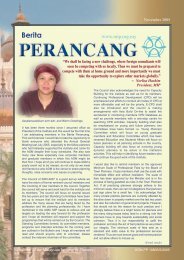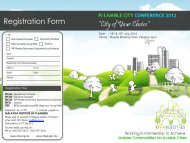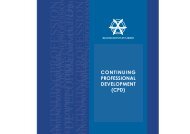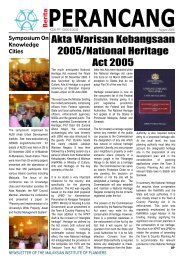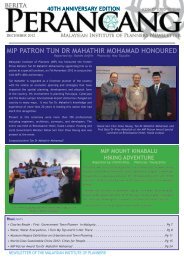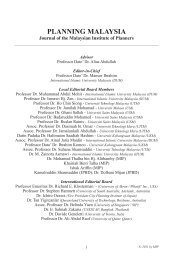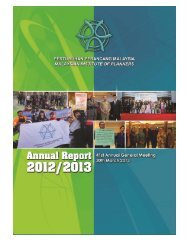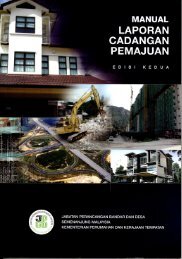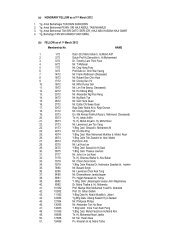Untitled - Malaysian Institute of Planners
Untitled - Malaysian Institute of Planners
Untitled - Malaysian Institute of Planners
Create successful ePaper yourself
Turn your PDF publications into a flip-book with our unique Google optimized e-Paper software.
Syazwani Sahrir, Syahriah Bachok & Mariana Mohd. OsmanThe Effectiveness <strong>of</strong> Provision <strong>of</strong> New Static Information Signage: A Case Study <strong>of</strong> IIUM, Gombakcontrol devices subscribed to the detailed requirements or conditions affectingroad use at specific places and times in order that proper actions may be takenso as to avoid accidents or delays (Cunard, 1999). Control devices are necessaryfor strangers to the locale or for the first time users. The underlying principles<strong>of</strong> traffic control devices are: 1) design factors, 2) position or placement, 3)maintenance <strong>of</strong> condition and visibility, and 4) uniformity <strong>of</strong> application anduse (Cunard, 1999).Traffic signs are signs erected at the side <strong>of</strong> roads to provide guidanceto the road users. Traffic sign can be divided into four which are: 1) warningsigns, 2) regulatory signs, 3) informatory signs and 4) direction signs (Slinn,Matthews and Guest, 2005). Traffic signs help creates a safer environment forroad users by visually communicating information relating to regulations,warnings, directional and locational guidance to drivers and pedestrians. Theinformation must be unambiguous and conveyed in a manner that is suited tothe type <strong>of</strong> road condition and traffic characteristics. Traffic signs play anincreasingly important role in daily traffic. Traffic Signs (Size, Colour andType) Rules 1959 by Department <strong>of</strong> Works Malaysia prescribe the types,meaning, dimension, colour, placement and height <strong>of</strong> signs under Part I throughto Part VI. Additionally, many studies have concentrated on the responses andimpacts <strong>of</strong> these types <strong>of</strong> signage (Abdur Razzak and Tanweer Hasan, 2010;Baas, 2000; Ng and Chan, 2008). However, in many other private roads whichare not regulated under these Acts, Rules and Regulations, several nonconventionaltypes <strong>of</strong> signages have been provided. There however a lack <strong>of</strong>study is on the impacts and drivers’ responses towards these signages.Accordingly, this research is to assess the effectiveness <strong>of</strong> informationsigns provision in International Islamic University Malaysia (IIUM), Gombakcampus. The findings from this study are very useful in the enhancement on theunderstanding <strong>of</strong> traffic regulations among <strong>of</strong> several important groups; rangingfrom the urban planning studies, road users and the IIUM community.Nevertheless, this research only focuses on the new informatory signs in IIUMGombak campus. The current informatory signs do not subscribe to theinformative signs provision under Part IV <strong>of</strong> the Rules (1995). Therefore, it willbe a useful reference for the campus management in providing better trafficsigns system in the future. The traffic sign has to be considered carefully when‘designing the street’. It is essential that the campus design translates theuniversity’s education philosophy. Thus, the physical forms and configurationsshall be conducive for the aims and objectives <strong>of</strong> the university.© 2012 by MIP



